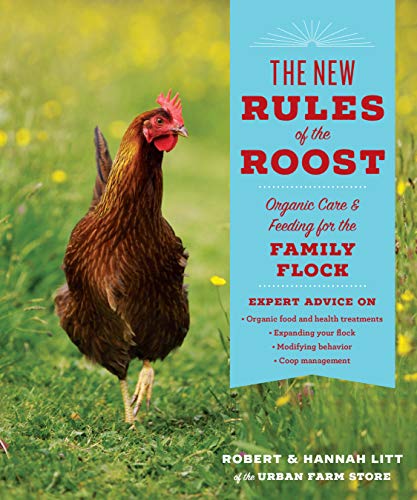 Robert and Hannah Litt of Portland wrote A Chicken in Every Yard, published in 2011. They regard their chickens as pets to pamper and keep safe – they only eat their eggs. This book will tell you how to do the same.
Robert and Hannah Litt of Portland wrote A Chicken in Every Yard, published in 2011. They regard their chickens as pets to pamper and keep safe – they only eat their eggs. This book will tell you how to do the same.
On a visit to the island of Kauai in Hawai’i, the Litt family discovered that chickens have naturalized and do quite well looking after themselves. This led to a new book, The New Rules of the Roost (2018) that incorporates some of this avian independence. Now the setting for their home flock is “more dynamic, so that our chickens can safely forage for food and scratch around, but when and where we want them to.”
How does all this work with the garden? Very well, if you consider the hens as part of the family – it just takes a lot of compromise and ingenuity.
Published in Garden Notes: Northwest Horticultural Society, Fall 2018
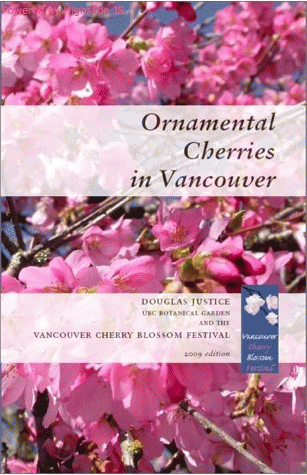 Douglas Justice of the University of British Columbia Botanical Garden is the author of “Ornamental Cherries in Vancouver”. Published by the Vancouver Cherry Blossom Festival, this excellent guide celebrates a rich collection of urban flowering cherries, some 40,000 trees as of the 125th anniversary of the city in 2011.
Douglas Justice of the University of British Columbia Botanical Garden is the author of “Ornamental Cherries in Vancouver”. Published by the Vancouver Cherry Blossom Festival, this excellent guide celebrates a rich collection of urban flowering cherries, some 40,000 trees as of the 125th anniversary of the city in 2011.
Ornamental cherries are a major component of the Washington Park Arboretum, especially along Azalea Way. This book’s photographs include close-ups of flowers and an example of the tree in a landscape. Leaves are described as they emerge, in the full leaf of summer, and as they color in the fall. Sadly, this book is hard to obtain (we are still hoping to add the 2014 edition to the Miller Library) and is not available to borrow and take with you strolling in the Arboretum next spring.
However, there is much to learn from a visit to the library. For example, the Yoshino cherry (Prunus x yedoensis ‘Somei-yoshino’) is of uncertain origin, but is famous for the Hanami (cherry viewing) festivals in Japan. This is also the cherry of the Tidal Basin in Washington, D. C. and at “The Quad” on the University of Washington campus. Another widely planted selection is the Kanzan or Kwanzan cherry (Prunus Sato-zakura Group ‘Kanzan’), perhaps because the “apparent good health of this cultivar often borders on the miraculous.”
Excerpted from the Fall 2018 Arboretum Bulletin.
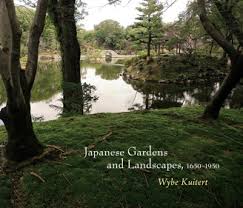 Wybe Kuitert has written two deeply researched books on the history of Japanese gardens. The first, “Themes in the History of Japanese Garden Art” (1st edition 1988, revised 2002 – this later edition is at the Miller Library), is the history from roughly 900 to 1650 CE, concluding when “the practice and theory of garden art became established in a way that does not differ much from our own days.”
Wybe Kuitert has written two deeply researched books on the history of Japanese gardens. The first, “Themes in the History of Japanese Garden Art” (1st edition 1988, revised 2002 – this later edition is at the Miller Library), is the history from roughly 900 to 1650 CE, concluding when “the practice and theory of garden art became established in a way that does not differ much from our own days.”
Kuitert’s new book, “Japanese Gardens and Landscapes, 1650-1950,” brings that history up to near present day. Despite his conclusion in the earlier book, I found this history surprisingly dynamic. During the Edo period (1603-1868), gardens of the “daimyo,” or regional rulers, became quite fanciful. “These were Disney-type re-creations that functioned primarily as leisure environments.”
This was also a time when variegated plants and flowers with unusual and flamboyant forms became popular. As printing techniques became more widely and cheaply available, there was an explosion of published gardening books, codifying some of the earlier customs but with a loss of their symbolism. Kuitert laments this, describing these books as only a “crowd-pleasing version of garden traditions and ideas.”
After Japan opened to the West in the mid-1800s, there was much upheaval in all ways of life, including gardening. Western-style gardens appeared and Japanese garden designers who studied in the West were in high demand.
For local readers, this book’s profile of Jūki Iida (1889/90-1977), the major designer of the Seattle Japanese Garden, will be of great interest. Kuitert reviews Iida’s early training and his developing understanding that there exist two worlds of Japanese gardening: the formal, built garden and the naturalistic garden. By his emphasizing the latter approach, Kuitert credits Iida as “a key figure in democratizing the long tradition of garden-making in Japan” and for making individual gardens more accessible to everyone.
Excerpted from the Fall 2018 Arboretum Bulletin.
![[The Bee Tree] cover](https://depts.washington.edu/hortlib/graphix/beetree.jpg)
The Bee Tree is composed of two parts. The first part will appeal to a younger audience, and presents in words and pictures the tradition of harvesting honey in the Malaysian rainforest. Bees build the honeycombs on the tualang trees, the tallest trees reaching heights of about 250 feet. Hauling their special tools, honey hunters climb the trees with skill and courage. Gathering the honeycombs is a cooperative venture with rituals that express gratitude for the food and medicine that honey provides. The hunters share their bounty with friends and neighbors, and also sell the honey in local markets. The honey hunt is central to the culture and way of life of the indigenous people of Malaysia.
The second part of the book covers basic background information for adults on Malaysia and its peoples, the rainforest, the giant honeybee, and the tradition and future of the honey hunters. As for the future for honeybees: “As long as there is the rainforest, there will be bees, and as long as there are bees, there will be honey, and as long as there is honey, there will be honey hunters.” The giant honeybee, Apis dorsata, is crucial as a pollinator. It is a keystone species, important in the preservation of the entire ecosystem in the rainforest. It is another beautiful example of the interaction of plants and pollinators and their importance to a culture that preserves natural systems.
Published in the August 2018 Leaflet, Volume 5, Issue 8.
![[Butterflies of the Pacific Northwest] cover](https://depts.washington.edu/hortlib/graphix/butterfliesofthepacificnorthwest.jpg)
Summer is a great time to see butterflies and now there is an excellent new field guide. Butterflies of the Pacific Northwest by Robert Michael Pyle and Caitlin C. LaBar is the perfect tool to guide you in identifying and learning about the more than 200 species that are native to Washington and Oregon. It “is intended for everyone who wishes to study, watch, collect, photograph, garden, or otherwise enjoy butterflies responsibly.”
This Timber Press Field Guide has a sturdy, rain-resistant cover designed for field use. The Miller Library copy is an important reference source and not available to check out, but you can use it to compare with your field notes. Alternatively, check out Pyle’s earlier (2002) The Butterflies of Cascadia. The major difference between two books is the quality of the photographs. The advent of digital photography and the special expertise that new co-author LaBar brings have produced stunning results.
Each description includes range maps (within Washington and Oregon), habitat, host plants, and when the species is “on the wing.” Carefully documented are the often significant differences between males and females, and between dorsal (with the wings open) and ventral (wings closed) views.
Pyle also writes poetry, and his pleasure in the subtleties of language is evident in the anecdotal section under each species. He describes unusual sightings, gives hints for distinguishing between similar species, and relishes quirks of nomenclature. If you are city bound this summer, he even identifies those species that thrive despite intense urban environments.
Published in the August 2018 Leaflet for Scholars, Volume 5 Issue 8.
![[The Quiet Extinction] cover](https://depts.washington.edu/hortlib/graphix/quietextinction.jpg)
The Quiet Extinction: Stories of North America’s Rare and Threatened Plants profiles plants native to the United States and Canada which are in danger of extinction. The causes vary, but humans are the main culprit, especially by driving climate change and loss of habitat.
While the topic is grim, author Kara Rogers has a knack for telling compelling stories, while still presenting good science. She wisely concentrates on a handful of species to drive her narrative, explaining that these are bellwethers of a much greater problem.
Some of these have special interest for Pacific Northwest readers. White bark pines (Pinus albicaulis) are a key species in the ecology of the Olympic and Cascade Mountains. They are facing a double whammy from white pine blister rust and outbreaks of mountain pine beetles. Hikers at high altitudes may recognize the problem, “but the real tragedy is that few people are aware that the region’s iconic tree and beautiful plants are disappearing and that they are doing so rapidly.”
As with many of these plants, their interaction with animals, including pollinators and herbivores, and with naturally occurring phenomena such as fire, are important parts of the story. This is an excellent book for anyone interested in the interconnections within North American ecosystems, as well as those fighting to reverse the plight of endangered plants.
Published in the July 2018 Leaflet for Scholars, Volume 5, Issue 7.
Editor’s note: A recent review by Dorothy Crandell asked readers “When is the right time to reread a classic?” In the spirit of that question, we’re taking a fresh look at some books that have been available here at the Miller Library for many years.
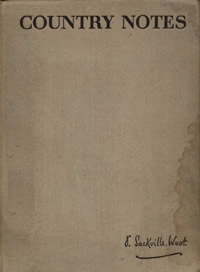
Country Notes is a collection of charming short articles, most of them originally published in New Statesman and Nation magazine in 1938 and 1939. They describe life on the farm as seen by Sackville-West from her estate, Sissinghurst, in Kent, England. She has a knack for description of botanical detail. For example, of the witch hazel she says the “dark brown twigs look as though some child had amused itself by tying them up with bunches of yellow ribbons, and then snipping the ends short.” The articles describe farm events such as harvesting hops and dealing with animals, including the horses still pulling plows. She also introduces local characters, like her gardener and the seasonal workers who camp out on the property during harvest time.
It is particularly intriguing to read this book in the context of its times. By the end of 1939, England was at war. In only one or two spots does the author mention “Herr Hitler” or the threat of conflict. But a cloud of worry must have hung over her writing. In addition, Sackville-West herself, in spite of her protesting that she loves the old ways, was part of the very modern Bloomsbury group, and was herself somewhat infamous for her multiple lovers, including Virginia Woolf. Beyond that background, Sackville-West was a well-known gardener, and wrote several books on gardening, including some in our library. A recent account of the history of her garden appears in Sissinghurst: An Unfinished History, by her grandson Adam Nicholson, also in our collection. So there is much to think about while enjoying these sketches of the Kentish countryside.
Published in the July 2018 Leaflet, Volume 5, Issue 7.
![[Incredible Edibles] cover](https://depts.washington.edu/hortlib/graphix/incredibleedibles.jpg)
My favorite publisher of travel guides is DK (Dorling Kindersley Limited). They do very well with gardening books, too, creating visually rich yet uncluttered plant encyclopedias.
A new favorite in this style is Incredible Edibles: Grow Something Different in your Fruit and Veg Plot. The use of the term “veg” is a clue that the author, Matthew Biggs, is British, but he writes for a global audience. But no worries, most of these edibles will do well in a Seattle garden.
Here is the opportunity to expand your palate. While many of the plants are exotic, others are already familiar to gardeners. Fuchsia berries, daylily flowers, and the leaves and flowers of your hosta border all provide tasty treats. Most surprising (for me) was learning that dahlias are edible.
The author typically points out the horticultural value of his subjects and has a knack for taste-tingling imagery. He describes Chilean guava (Ugni molinae) as being a favorite of Queen Victoria because the fruits have little crowns. In addition, “the aromatic fruits are the size of blackcurrants, but taste like wild strawberries and bubblegum. It really should be more widely grown.”
Northwest natives, such as camas and Oregon grape, are included. Never taken a class on cooking camas? A sidebar of “cook’s tips” will get you started. We purchased this fun book with a grant from the Washington State Nursery and Landscape Association.
Published in the July 2018 Leaflet, Volume 5, Issue 7.
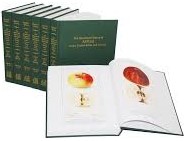 “The Illustrated History of Apples in the United States and Canada” is a seven-volume set with description of all apples found in North American publications through 2000. The information will have immense importance to any pomology researcher, but the more casual reader will find pleasure in the beautiful images: 1,400 watercolors created by artists employed by the United States Department of Agriculture from 1886-1942.
“The Illustrated History of Apples in the United States and Canada” is a seven-volume set with description of all apples found in North American publications through 2000. The information will have immense importance to any pomology researcher, but the more casual reader will find pleasure in the beautiful images: 1,400 watercolors created by artists employed by the United States Department of Agriculture from 1886-1942.
Excerpted from the Summer 2018 Arboretum Bulletin.
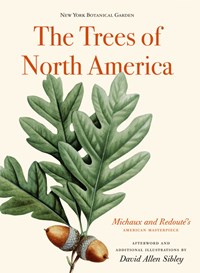 “The Trees of North America” is an excellent new book and winner of one of the three book awards given by the AHS in 2018. Who is the author? It’s complicated.
“The Trees of North America” is an excellent new book and winner of one of the three book awards given by the AHS in 2018. Who is the author? It’s complicated.
The short answer is François-André Michaux (1770-1855) and Thomas Nuttall (1786-1859) with considerable help from skilled engravers, the most famous being Pierre-Joseph Redouté (1759-1840). Their collective publications span the first half of the 19th century, produced in both France and the United States, and first in French and later in English. The full bibliographic story is in the preface of this new book.
The New York Botanical Garden (NYBG) in their LuEsther T. Mertz Library has perhaps the most complete collection of the (at least) 16 different editions by Michaux and Nuttall. Mertz Library staff have produced this new book, using faithful reproductions of the plates. The horticulture staff for NYBG add notes with current updates of nomenclature, ranges, and horticultural uses.
Enough words. This is mostly a picture book, but what a glorious one it is. We are fortunate to have an 1857-1865 original in the Miller Library rare book collection. While a reprint can never quite match a hand-colored original, this comes very close.
These accurate images made the original the standard reference book for North America trees until the early 20th century. A concluding essay by David Allen Sibley explains the process of making the reprinted images – a process as complex as the authorship. Sibley declares, “The end results are beautiful, and the prints are true works of art on their own, but they are different from the originals.”
Excerpted from the Summer 2018 Arboretum Bulletin.
 Robert and Hannah Litt of Portland wrote A Chicken in Every Yard, published in 2011. They regard their chickens as pets to pamper and keep safe – they only eat their eggs. This book will tell you how to do the same.
Robert and Hannah Litt of Portland wrote A Chicken in Every Yard, published in 2011. They regard their chickens as pets to pamper and keep safe – they only eat their eggs. This book will tell you how to do the same. Wybe Kuitert has written two deeply researched books on the history of Japanese gardens. The first, “Themes in the History of Japanese Garden Art” (1st edition 1988, revised 2002 – this later edition is at the Miller Library), is the history from roughly 900 to 1650 CE, concluding when “the practice and theory of garden art became established in a way that does not differ much from our own days.”
Wybe Kuitert has written two deeply researched books on the history of Japanese gardens. The first, “Themes in the History of Japanese Garden Art” (1st edition 1988, revised 2002 – this later edition is at the Miller Library), is the history from roughly 900 to 1650 CE, concluding when “the practice and theory of garden art became established in a way that does not differ much from our own days.”![[The Bee Tree] cover](https://depts.washington.edu/hortlib/graphix/beetree.jpg)
![[Butterflies of the Pacific Northwest] cover](https://depts.washington.edu/hortlib/graphix/butterfliesofthepacificnorthwest.jpg)
![[The Quiet Extinction] cover](https://depts.washington.edu/hortlib/graphix/quietextinction.jpg)

![[Incredible Edibles] cover](https://depts.washington.edu/hortlib/graphix/incredibleedibles.jpg)
 “The Illustrated History of Apples in the United States and Canada” is a seven-volume set with description of all apples found in North American publications through 2000. The information will have immense importance to any pomology researcher, but the more casual reader will find pleasure in the beautiful images: 1,400 watercolors created by artists employed by the United States Department of Agriculture from 1886-1942.
“The Illustrated History of Apples in the United States and Canada” is a seven-volume set with description of all apples found in North American publications through 2000. The information will have immense importance to any pomology researcher, but the more casual reader will find pleasure in the beautiful images: 1,400 watercolors created by artists employed by the United States Department of Agriculture from 1886-1942. “The Trees of North America” is an excellent new book and winner of one of the three book awards given by the AHS in 2018. Who is the author? It’s complicated.
“The Trees of North America” is an excellent new book and winner of one of the three book awards given by the AHS in 2018. Who is the author? It’s complicated.